家庭农场外文翻译
农业经济学英汉互译
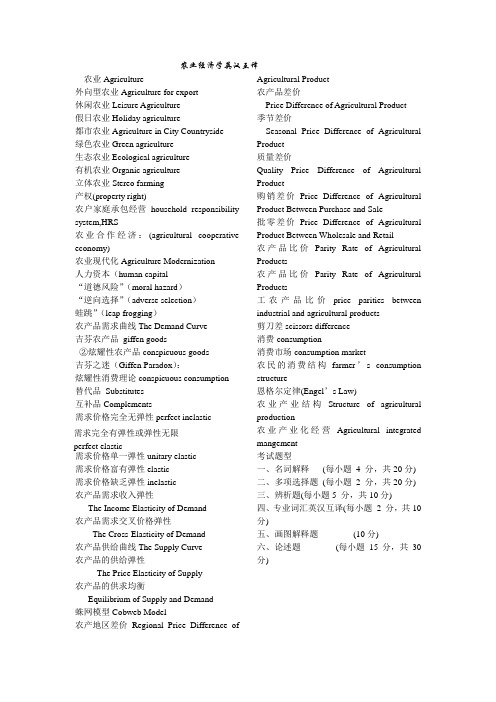
农业经济学英汉互译农业Agriculture外向型农业Agriculture for export休闲农业Leisure Agriculture假日农业Holiday agriculture都市农业Agriculture in City Countryside绿色农业Green agriculture生态农业Ecological agriculture有机农业Organic agriculture立体农业Stereo farming产权(property right)农户家庭承包经营household responsibility system,HRS农业合作经济:(agricultural cooperative economy)农业现代化Agriculture Modernization人力资本(human capital“道德风险”(moral hazard)“逆向选择”(adverse selection)蛙跳”(leap frogging)农产品需求曲线The Demand Curve吉芬农产品giffen goods②炫耀性农产品conspicuous goods吉芬之迷(Giffen Paradox):炫耀性消费理论conspicuous consumption替代品Substitutes互补品Complements需求价格完全无弹性perfect inelastic需求价格单一弹性unitary elastic需求价格富有弹性elastic需求价格缺乏弹性inelastic农产品需求收入弹性The Income Elasticity of Demand农产品需求交叉价格弹性The Cross-Elasticity of Demand农产品供给曲线The Supply Curve农产品的供给弹性The Price Elasticity of Supply农产品的供求均衡Equilibrium of Supply and Demand蛛网模型Cobweb Model农产地区差价Regional Price Difference of Agricultural Product农产品差价Price Difference of Agricultural Product季节差价Seasonal Price Difference of Agricultural Product质量差价Quality Price Difference of Agricultural Product购销差价Price Difference of Agricultural Product Between Purchase and Sale批零差价Price Difference of Agricultural Product Between Wholesale and Retail农产品比价Parity Rate of Agricultural Products农产品比价Parity Rate of Agricultural Products工农产品比价price parities between industrial and agricultural products剪刀差scissors difference消费consumption消费市场consumption market农民的消费结构farmer’s consumption structure恩格尔定律(Engel’s Law)农业产业结构Structure of agricultural production农业产业化经营Agricultural integrated mangement考试题型一、名词解释(每小题4 分,共20分)二、多项选择题(每小题2 分,共20分)三、辨析题(每小题5 分,共10分)四、专业词汇英汉互译(每小题2 分,共10分)五、画图解释题(10分)六、论述题(每小题15分,共30分)需求完全有弹性或弹性无限perfect elastic。
农场的英语知识点归纳总结
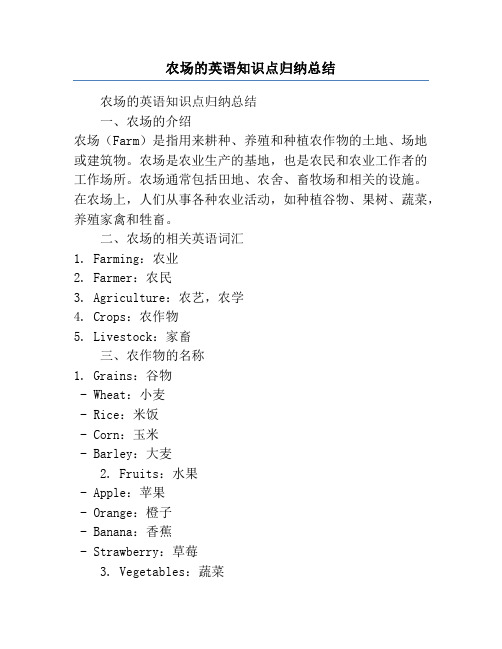
农场的英语知识点归纳总结农场的英语知识点归纳总结一、农场的介绍农场(Farm)是指用来耕种、养殖和种植农作物的土地、场地或建筑物。
农场是农业生产的基地,也是农民和农业工作者的工作场所。
农场通常包括田地、农舍、畜牧场和相关的设施。
在农场上,人们从事各种农业活动,如种植谷物、果树、蔬菜,养殖家禽和牲畜。
二、农场的相关英语词汇1. Farming:农业2. Farmer:农民3. Agriculture:农艺,农学4. Crops:农作物5. Livestock:家畜三、农作物的名称1. Grains:谷物- Wheat:小麦- Rice:米饭- Corn:玉米- Barley:大麦2. Fruits:水果- Apple:苹果- Orange:橙子- Banana:香蕉- Strawberry:草莓3. Vegetables:蔬菜- Carrot:胡萝卜- Potato:土豆- Tomato:西红柿- Cabbage:卷心菜四、动物的名称1. Livestock:家畜- Cattle:牛- Pig:猪- Sheep:绵羊- Chicken:鸡2. Domestic Animals:家养动物 - Dog:狗- Cat:猫- Horse:马- Rabbit:兔子五、农业工具和设备1. Tools:工具- Shovel:铲子- Hoe:锄头- Rake:耙子- Pitchfork:叉子2. Equipment:设备- Tractor:拖拉机- Harvester:收割机- Irrigation System:灌溉系统- Greenhouse:温室六、农场日常活动1. Planting crops:种植农作物2. Harvesting crops:收割农作物3. Feeding livestock:喂养家畜4. Milking cows:挤牛奶5. Mending fences:修补栅栏6. Irrigating fields:灌溉田地7. Cleaning barns:清洁谷仓8. Controlling pests:控制害虫七、农场管理和经营1. Farm Management:农场管理2. Crop Rotation:轮作3. Pest Control:害虫防治4. Organic Farming:有机农业5. Sustainable Agriculture:可持续农业6. Livestock Breeding:畜牧养殖7. Crop Yield:农作物产量8. Market Prices:市场价格八、农产品的生产和销售1. Agricultural Production:农产品生产2. Farmers' Market:农民市场3. Wholesale:批发4. Retail:零售5. Export:出口6. Import:进口7. Supply and Demand:供求关系九、农业发展与环境保护1. Sustainable Development:可持续发展2. Soil Conservation:土壤保护3. Water Management:水资源管理4. Biodiversity:生物多样性5. Crop Rotation:轮作6. Organic Farming:有机农业7. Environmental Impact:环境影响总结:农场是农业生产的基地,涵盖了种植、养殖等多个方面的活动。
常识词汇1
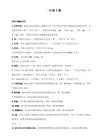
winepress 葡萄榨汁机
milking machine 挤奶机
churn 搅乳器
cereals, grain 谷物
coarse grain 谷粒
rye 黑麦
barley 大麦
oats 燕麦
millet 粟,黍
sorghum 高粱
bran 麸,糠
horticulture 园艺
market gardening 商品蔬菜种植业
fruit growing 果树栽培
vinegrowing, viticulture 葡萄栽培
olive growing 油橄榄栽培
arboriculture 树艺学
silviculture 造林学
weeding hoe 除草锄
mechanical hoe 动力锄
rake 搂草机
fork 叉子
hayfork, pitchfork 干草叉
scythe 大钐刀
sickle 镰刀
flail 连枷
billhook, brushhook 钩镰
(field)roller 滚压器
agricultural, commodities market 农业市场
livestock 牲畜
farmhouse 农舍
pasture 牧场
overalls 稻草人
haystacks 大干草垛
silo 筒仓
granary 谷仓
outbuildings 附属建筑
barn, shed 棚
to transplant, to plant out 移植
seed 种子
农业英语词汇(中英)
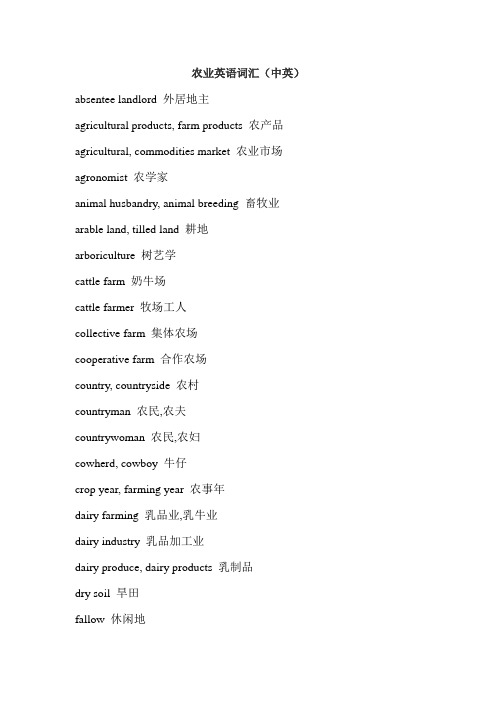
农业英语词汇(中英)absentee landlord 外居地主agricultural products, farm products 农产品agricultural, commodities market 农业市场agronomist 农学家animal husbandry, animal breeding 畜牧业arable land, tilled land 耕地arboriculture 树艺学cattle farm 奶牛场cattle farmer 牧场工人collective farm 集体农场cooperative farm 合作农场country, countryside 农村countryman 农民,农夫countrywoman 农民,农妇cowherd, cowboy 牛仔crop year, farming year 农事年dairy farming 乳品业,乳牛业dairy industry 乳品加工业dairy produce, dairy products 乳制品dry soil 旱田fallow 休闲地farm hand 农场短工farm labourers 农场工人,农业工人(美作:farm laborers) farm 农场farmer 农户farming, husbandry 农业fertile soil 沃土,肥沃的土壤foodstuffs 食品fruit grower 果农fruit growing 果树栽培grass 草grassland 草地hacienda 庄园holding 田产horticulture 园艺humus 腐殖质irrigable land 水浇地land reform, agrarian reform 土地改革land,soil 土壤landowner 地主,土地拥有者latifundium, large landed estate 大农场主lean soil, poor soil 贫瘠土壤livestock 牲畜market gardening 商品蔬菜种植业meadow 草甸mechanization of farming 农业机械化mechanized farming 机械化耕作olive growing 油橄榄栽培pasture land 牧场plot, parcel, lot 地块ploughman 农夫,犁田者prairie 大草原producer 农业工人ranch 大农场,牧场rancher 牧场主rural exodus 农村迁徙rural population 农村人口season 季节settle 佃户sharecropper 佃农shepherd 牧人silviculture 造林学smallholder, small farmer 小农straw, hay 稿杆stubble, stubble field 亩茬地tenant farmer, leaseholder 土地租用人to lie fallow 休闲vinegrower 葡萄栽植者vinegrowing, viticulture 葡萄栽培vintager 采葡萄者wasteland, barren land 荒地。
家庭农场的简介范文1500字
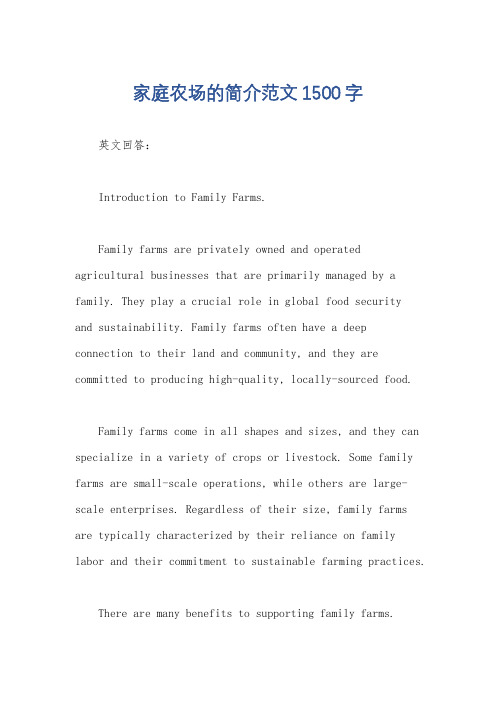
家庭农场的简介范文1500字英文回答:Introduction to Family Farms.Family farms are privately owned and operatedagricultural businesses that are primarily managed by a family. They play a crucial role in global food securityand sustainability. Family farms often have a deep connection to their land and community, and they are committed to producing high-quality, locally-sourced food.Family farms come in all shapes and sizes, and they can specialize in a variety of crops or livestock. Some family farms are small-scale operations, while others are large-scale enterprises. Regardless of their size, family farms are typically characterized by their reliance on familylabor and their commitment to sustainable farming practices.There are many benefits to supporting family farms.Family farms help to preserve the rural landscape, protect the environment, and promote local economic development. They also provide consumers with access to fresh, healthy, and locally-sourced food.Challenges Facing Family Farms.Family farms face a number of challenges, including:Economic pressures: Family farms are often at a disadvantage compared to larger, corporate farms. They may have difficulty accessing capital and land, and they may be more vulnerable to fluctuations in commodity prices.Environmental pressures: Family farms are often affected by climate change, pests, and diseases. They may also face pressure to convert their land to non-agricultural uses.Social pressures: Family farms are often affected by changes in the rural economy and community. They may also face pressure to sell their land or to transition to a non-family farm model.Supporting Family Farms.There are a number of ways to support family farms, including:Buying food from family farms: Consumers can support family farms by buying food from local farmers' markets, CSAs, and farm stands.Donating to family farm organizations: There are a number of organizations that support family farms. Consumers can donate to these organizations to help them provide resources and assistance to family farmers.Advocating for policies that support family farms: Consumers can advocate for policies that support family farms by contacting their elected officials and supporting organizations that work to protect family farms.中文回答:家庭农场简介。
英语作文介绍农场
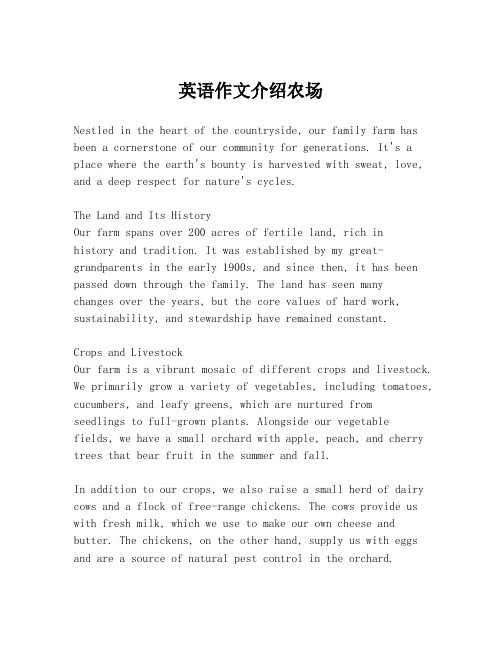
英语作文介绍农场Nestled in the heart of the countryside, our family farm has been a cornerstone of our community for generations. It's a place where the earth's bounty is harvested with sweat, love, and a deep respect for nature's cycles.The Land and Its HistoryOur farm spans over 200 acres of fertile land, rich inhistory and tradition. It was established by my great-grandparents in the early 1900s, and since then, it has been passed down through the family. The land has seen manychanges over the years, but the core values of hard work, sustainability, and stewardship have remained constant.Crops and LivestockOur farm is a vibrant mosaic of different crops and livestock. We primarily grow a variety of vegetables, including tomatoes, cucumbers, and leafy greens, which are nurtured fromseedlings to full-grown plants. Alongside our vegetablefields, we have a small orchard with apple, peach, and cherry trees that bear fruit in the summer and fall.In addition to our crops, we also raise a small herd of dairy cows and a flock of free-range chickens. The cows provide us with fresh milk, which we use to make our own cheese and butter. The chickens, on the other hand, supply us with eggs and are a source of natural pest control in the orchard.Sustainability PracticesWe are committed to sustainable farming practices thatprotect the environment and ensure the health of our land. We use organic methods to control pests and diseases, avoidingthe use of harmful chemicals. Our farm also employsrotational cropping and cover cropping to maintain soilfertility and structure.Community InvolvementOur farm is not just a place of work; it's a hub for the community. We host annual events like the Harvest Festival, where neighbors come together to celebrate the fruits of our labor. We also offer farm tours and workshops to educate the public about farming and the importance of local food systems.The FutureAs we look to the future, we are excited to continue thelegacy of our family farm. We are exploring new technologies and methods to improve our farming practices and to make our farm even more sustainable. Our goal is to leave a lasting legacy for future generations, a place where the land is respected, and the community thrives.In conclusion, our family farm is more than just a placewhere food is grown; it's a testament to the hard work, dedication, and love that goes into every harvest. It's a living, breathing entity that connects us to the land and to each other, and we are proud to share its story with you.。
农场的英语单词
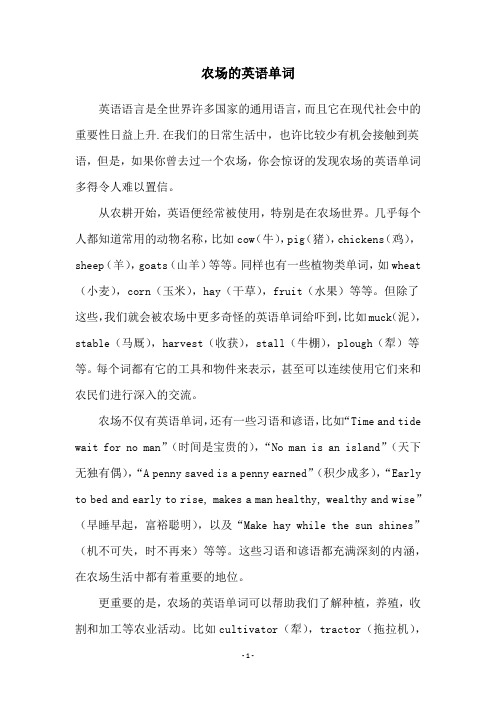
农场的英语单词英语语言是全世界许多国家的通用语言,而且它在现代社会中的重要性日益上升.在我们的日常生活中,也许比较少有机会接触到英语,但是,如果你曾去过一个农场,你会惊讶的发现农场的英语单词多得令人难以置信。
从农耕开始,英语便经常被使用,特别是在农场世界。
几乎每个人都知道常用的动物名称,比如cow(牛),pig(猪),chickens(鸡),sheep(羊),goats(山羊)等等。
同样也有一些植物类单词,如wheat (小麦),corn(玉米),hay(干草),fruit(水果)等等。
但除了这些,我们就会被农场中更多奇怪的英语单词给吓到,比如muck(泥),stable(马厩),harvest(收获),stall(牛棚),plough(犁)等等。
每个词都有它的工具和物件来表示,甚至可以连续使用它们来和农民们进行深入的交流。
农场不仅有英语单词,还有一些习语和谚语,比如“Time and tide wait for no man”(时间是宝贵的),“No man is an island”(天下无独有偶),“A penny saved is a penny earned”(积少成多),“Early to bed and early to rise, makes a man healthy, wealthy and wise”(早睡早起,富裕聪明),以及“Make hay while the sun shines”(机不可失,时不再来)等等。
这些习语和谚语都充满深刻的内涵,在农场生活中都有着重要的地位。
更重要的是,农场的英语单词可以帮助我们了解种植,养殖,收割和加工等农业活动。
比如cultivator(犁),tractor(拖拉机),harvester(收获机),sheller(去壳机),husker(玉米撕米机)等等,这些有关机械设备和加工过程的单词,都可以帮助我们更好地理解农业技术与农业生产。
总而言之,农场的英语单词,不仅仅是一些动物名称和植物名称,它们还可以帮助我们了解更多的农业技术,从而更好地把握农业的理论与实践,让我们向可持续发展的未来迈进。
雅思口语Part1话题:Farming
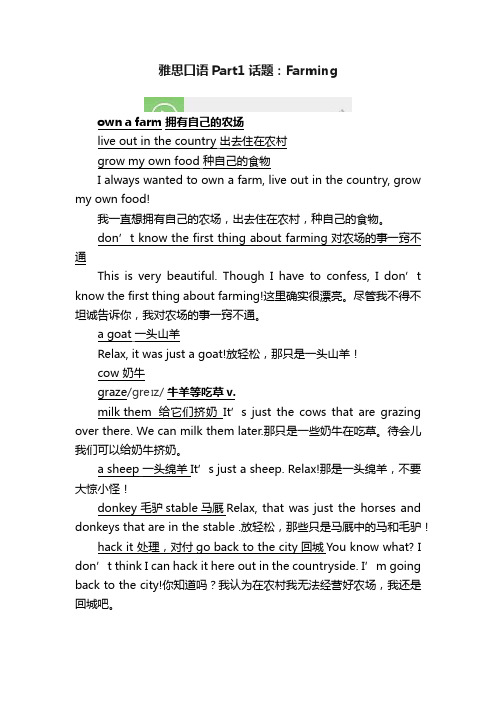
don’t know the first thing about farming 对农场的事一窍不通
This is very beautiful. Though I have to confess, I don’t know the first thing about farming!这里确实很漂亮。尽管我不得不坦诚告诉你,我对农场的事一窍不通。
a goat一头山羊
Relax, it was just a goat!放轻松,那只是一头山羊!
cow 奶牛
graze/ɡreɪz/牛羊等吃草v.
milk them 给它们挤奶It’s just the cows that are grazing over there. We can milk them later.那只是一些奶牛在吃草。待会儿我们可以给奶牛挤奶。
hack it 处理,对付go back to the city 回城You know what? I don’t think I can hack it here out in the countryside. I’m going back to the city!你知道吗?我认为在农村我无法经营好农场,我还是回城吧。
a sheep一头绵羊It’s just a sheep. Relax!那是一头绵羊,不要大惊小怪!
donkey 毛驴stable 马厩Relax, that was just the horses and donkeys that are in the stable .放轻松,那些只是马厩中的马和毛驴!
我一直想拥有自己的农场出去住在农村种自己的食物
雅思口语Part1话题:Farming
farmhouse造句
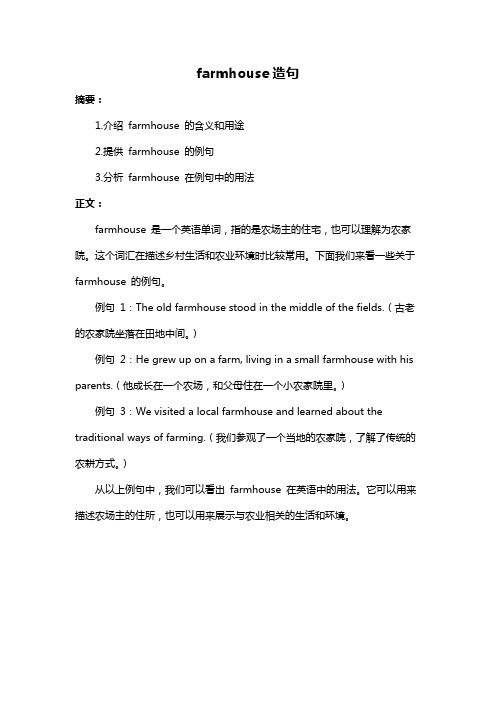
farmhouse造句
摘要:
1.介绍farmhouse 的含义和用途
2.提供farmhouse 的例句
3.分析farmhouse 在例句中的用法
正文:
farmhouse 是一个英语单词,指的是农场主的住宅,也可以理解为农家院。
这个词汇在描述乡村生活和农业环境时比较常用。
下面我们来看一些关于farmhouse 的例句。
例句1:The old farmhouse stood in the middle of the fields.(古老的农家院坐落在田地中间。
)
例句2:He grew up on a farm, living in a small farmhouse with his parents.(他成长在一个农场,和父母住在一个小农家院里。
)
例句3:We visited a local farmhouse and learned about the traditional ways of farming.(我们参观了一个当地的农家院,了解了传统的农耕方式。
)
从以上例句中,我们可以看出farmhouse 在英语中的用法。
它可以用来描述农场主的住所,也可以用来展示与农业相关的生活和环境。
家庭农场
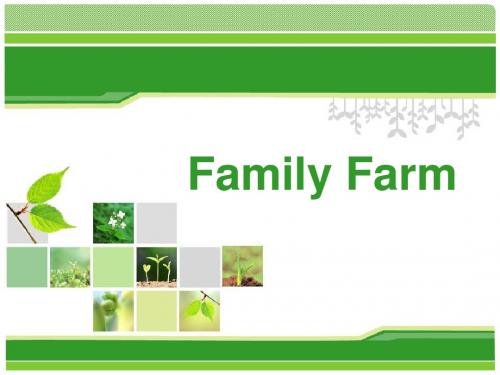
The French family farm
• characteristics
1、Family business 2、Scientific farming 3、Industrialization management
Japanese family farm
• Characteristics
1、Combination and separation 2、Transfer and concentration
• around 80 % of the 9,100 hectares of arable land in Songjiang is operated by about 1200 family farms.
Definition
• The main labor are family members • large scale, commercial, specialized farming • the main income of the family is from agriculture area.
• new-type agricultural operation entities Family farm
farmers cooperatives
professional large family
• new-type agricultural operation entities Family farm
household contract operation system
farmers cooperatives
professional large family
Part2: Importance
• The put forward of the family farm conform to the new trend of the current agricultural development.
实用的农业英语词汇
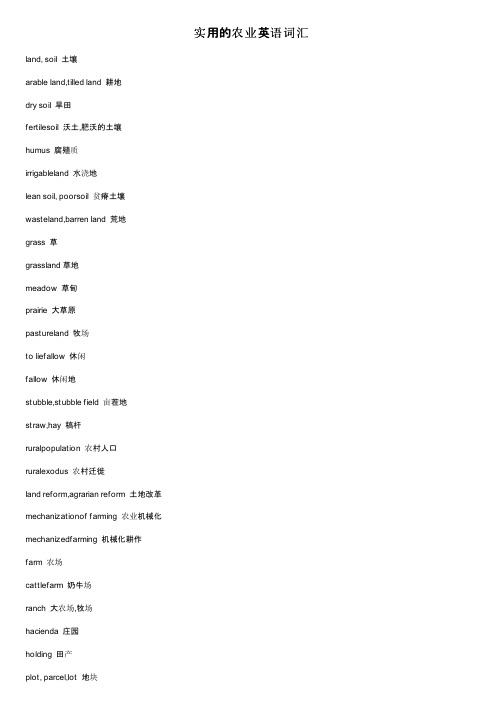
实用的农业英语词汇land, soil 土壤arable land,tilled land 耕地dry soil 旱田fertilesoil 沃土,肥沃的土壤humus 腐殖质irrigableland 水浇地lean soil, poorsoil 贫瘠土壤wasteland,barren land 荒地grass 草grassland 草地meadow 草甸prairie 大草原pastureland 牧场to liefallow 休闲fallow 休闲地stubble,stubble field 亩茬地straw,hay 稿杆ruralpopulation 农村人口ruralexodus 农村迁徙land reform,agrarian reform 土地改革mechanizationof farming 农业机械化mechanizedfarming 机械化耕作farm 农场cattlefarm 奶牛场ranch 大农场,牧场hacienda 庄园cooperativefarm 合作农场collectivefarm 集体农场country,countryside 农村countryman 农民,农夫countrywoman 农民,农妇agronomist 农学家latifundium,large landed estate 大农场主farmer 农户producer 农业工人settle 佃户landowner 地主,土地拥有者absenteelandlord 外居地主smallholder,small farmer 小农rancher 牧场主tenant farmer,leaseholder 土地租用人sharecropper 佃农ploughman 农夫,犁田者farmlabourers 农场工人,农业工人 (美作:farm laborers) farm hand 农场短工cattlefarmer 牧场工人cowherd,cowboy 牛仔shepherd 牧人fruit grower 果农vinegrower 葡萄栽植者vintager 采葡萄者farming,husbandry 农业animalhusbandry, animal breeding 畜牧业marketgardening 商品蔬菜种植业fruitgrowing 果树栽培vinegrowing,viticulture 葡萄栽培olivegrowing 油橄榄栽培arboriculture 树艺学silviculture 造林学agriculturalproducts, farm products 农产品foodstuffs 食品dairy produce,dairy products 乳制品dairyindustry 乳品加工业crop year,farming year 农事年season 季节agricultural,commodities market 农业市场livestock 牲畜farming and herding 农场和牧场farmhouse 农舍pasture 牧场overalls 稻草人haystacks 大干草垛silo 筒仓granary 谷仓outbuildings 附属建筑barn,shed 棚granary, grainstore 粮仓chickenhouse 鸡场windmill 磨坊implementshed 农具房litter 褥草cowshed 牛棚corral 围栏dairybarn 挤奶厂pigpen 猪圈 (美作:hogpen)sheep pen,fold 羊圈rabbithutch 兔窝hen house,henroost 鸡舍incubator,brooder 孵卵室layinghouse 产蛋室wateringtrough, drinking trough 饮水器piglet 猪仔boar 公猪feeding trough,feed trough 喂食器feeding rack,manger, crib 饲槽greenhouse,glasshouse 温室nursery 苗圃seedbed 苗床threshingfloor 打谷场manure heap,dung heap 麦堆field 田地cornfield 麦地furrow 沟,渠ridge 垅clod 土块terrace 梯田plantation 栽植cabbagepatch 圆白菜地tomatopatch 土豆地vineyard 葡萄园kitchengarden 菜园marketgarden 商品菜园orchard 果园cultivate 耕作landtenure 土地所有制tenancy,leasing, lease 租佃land settlementpolicy 殖民政策,移民政策landconsolidation 土地集约to cultivate,to farm 耕作to till, tomanage, to run 经营dryfarming 旱作农业irrigatedfarming 灌溉农业extensivecultivation 粗放耕作intensivecultivation 集约耕作croprotation 轮作mixedfarming 多种经营single-cropfarming 单一经营to clear 采伐to weed 除草to plough 犁,耕 (美作:to plow) ploughing 耕作 (美作:plowing)to fallow, toplough up, to turn 休闲to earthup 覆土to harrow, torake 耙to grow 栽培to plant 栽植to transplant,to plant out 移植seed 种子to sow 播种broadcasting,broadcast sowing 撒播to stake 支木柱stake 支柱to prune 修剪,整枝pruning 修剪,整枝to graft 嫁接toharvest 收获harvest,harvesting 收获reaping 收割to pick 采摘picking 采摘to cut, tomow 刈割cutting,mowing 刈割to thresh 脱粒threshing 脱粒haymaking 割晒牧草to bind(intosheaves) 捆,扎to ensile, topit 青贮soilimprovement, soil dressing 土壤改良landreclamation 开垦荒地to manure 施肥fertilizer 化学肥料tofertilize 施化肥spreading 撒布tofumigate 熏蒸to spray 喷射insecticide 杀虫剂pesticide 农药weed killer,herbicide 除草剂pest 农业害虫parasite 寄生虫locust 蝗虫termite 白蚁rodent 啮齿类weeds 杂草rust 锈病smut 黑穗病mildew 霉病ergot 麦角phylloxera 葡萄根病蚜agricultural equipment 农机设备shovel 铁锹spade 铲hoe 锄weedinghoe 除草锄mechanicalhoe 动力锄rake 搂草机scythe 大钐刀sickle 镰刀flail 连枷billhook,brushhook 钩镰(field)roller 滚压器plough 犁 (美作:plow)ridging plough,ridger 起垄犁weedingmachine 除草机weeder, weedinghook 除草锄weedingfork 除草叉discharrow 圆盘耙clodcrusher 碎土块机tractor 拖拉机sprinkler 喷水器,人工降雨器manurespreader 撒肥机fertilizerdistributor 化肥撒肥机rotovator 中耕机 (美作:cultivator) planter 种植机diskharrow 圆盘耙cottonpicker 摘棉机potatoharvester 马铃薯收割机seeder,broadcaster 播种机seed drill,drilling machine 条播机mower 割草机(power)mower 动力割草机harvester,reaper 收割机combine(harvester) 联合收割机harvestingmachinery 收割机械threshingmachine, thresher 脱粒机winnower,winnowing machine 风选机sheafer 束禾机grader,sorter 分类机,分级机sieve 细筛winepress 葡萄榨汁机milkingmachine 挤奶机churn 搅乳器farm product and pastureproduct 农牧产品cereals,grain 谷物coarsegrain 谷粒rye 黑麦barley 大麦oats 燕麦millet 粟,黍sorghum 高粱bran 麸,糠flour,meal 粗磨谷粉wheat 小麦maize 玉米 (美作:corn)maize cob 玉米棒子 (美作:corncob)rice 稻buckwheat 荞麦tea 茶coffee 咖啡cocoa 可可树hop 蛇麻,啤酒花tubercrops 块茎作物sugarbeet 糖用甜菜potato 马铃薯sweetpotato 甘薯vegetables 蔬菜carrot 胡萝卜cassava,manioc 木薯turnip 芜菁yam 山药,薯蓣pulses,leguminous plants 豆类植物bean 菜豆pea 豌豆chick-pea 鹰嘴豆lentil 小扁豆soya bean 大豆 (美作:soybean) forageplants 饲料食物foddergrain 饲用谷物clover 三叶草lucern,lucerne 苜蓿 (美作:alfalfa) textileplants 纤维植物cotton 棉,草棉flax 亚麻hemp 大麻Americanagave 龙舌兰sisal 剑麻,西沙尔麻kapoktree 木棉树raffia 酒椰yucca 丝兰oilplants 油料植物sunflower 向日葵groundnut,peanut 落花生olive 油橄榄olivetree 油橄榄树sesame 芝麻castor oilplant 蓖麻rape seed 油菜籽rubbertree 橡胶树resinplant 树脂植物正能量的话语,果断收藏并分享,我做到了,你呢?欢迎关注富源牧业微信公众平台!请在“查找公众账号”中直接搜索“富源之声”关注我们,与微友一起学习,一起成长!。
家庭农场外文翻译
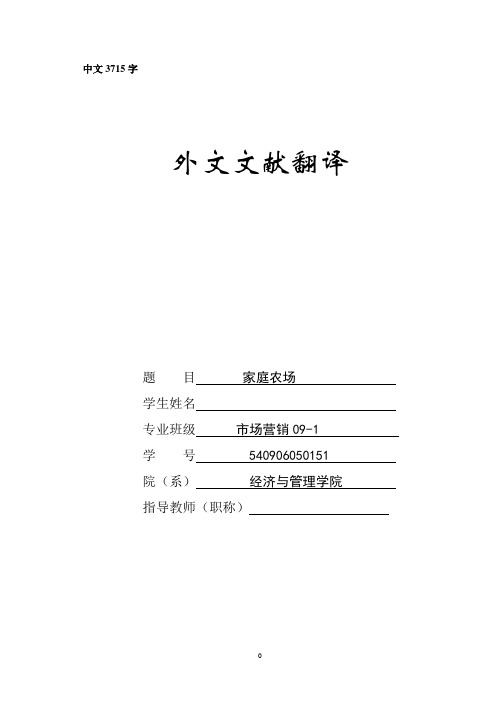
中文3715字外文文献翻译题目家庭农场学生姓名专业班级市场营销09-1学号 540906050151院(系)经济与管理学院指导教师(职称)家庭农场Lee, Jennifer Dukes U.S. Dept. of Agriculture, Economic Research Service New York摘要家庭农场是一个农场拥有和经营的家庭像其他家族企业和房地产的所有权,往往会给下一代的传承。
这是许多人类历史的主要是农业经济的基本单元,并继续在发展中国家。
家庭农场的替代品,包括那些由农业,俗称“工厂化农场,或通过集体农业。
关键词家庭农场/现代农业/发展/策略1 美国的法律定义所定义的美国农业部规定农场的贷款项目(例如那些由农业服务局管理),一个家庭农场是一个农场:(1)生产销售的农产品,这样的数量,是在社会公认的一个农场,没有农村住宅;(2)产生足够的收入(包括非农就业)支付的家庭和农场经营费用,偿还债务,并保持性能;(3)是由运营商管理;(4)具有通过运营商和运营商的家庭提供大量劳动力(5)可能在高峰时段和全职雇佣劳动力合理使用季节性劳动。
2 家庭农场的看法在发达国家的家庭农场是感伤的,为的是保存传统的缘故,一种生活方式,或是与生俱来的权利。
它往往对农业政策变化的政治口号是在这些国家,最常见的是在法国,日本,和美国,在农村的生活方式经常被看作是可取的。
在这些国家,同床异梦常常可以发现争论类似措施尽管在政治意识形态否则巨大差异。
例如,帕特里克布坎南和拉尔夫纳德,两位候选人在美国总统办公室举行集会,农村一起为维护所谓的家庭农场措施说话。
在其他经济事项,它们被视为普遍的反对,但发现这一共同点。
家庭农场的社会角色变化很大的今天。
直到最近,在与传统和保守的社会学,线家庭的头通常是最古老的人,紧随其后的是他的儿子。
妻子一般照顾家务,养育孩子,和财务事项有关的农场。
然而,农业活动已采取多种形式和随时间的变化。
家庭农场英语
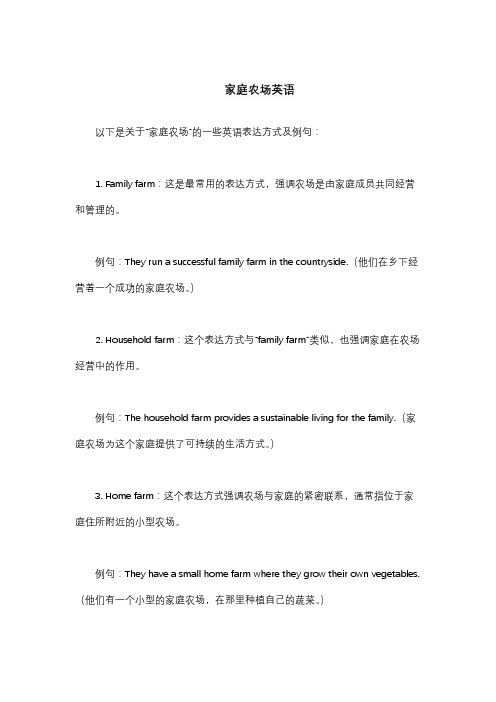
家庭农场英语
以下是关于“家庭农场”的一些英语表达方式及例句:
1. Family farm:这是最常用的表达方式,强调农场是由家庭成员共同经营和管理的。
例句:They run a successful family farm in the countryside.(他们在乡下经营着一个成功的家庭农场。
)
2. Household farm:这个表达方式与“family farm”类似,也强调家庭在农场经营中的作用。
例句:The household farm provides a sustainable living for the family.(家庭农场为这个家庭提供了可持续的生活方式。
)
3. Home farm:这个表达方式强调农场与家庭的紧密联系,通常指位于家庭住所附近的小型农场。
例句:They have a small home farm where they grow their own vegetables.(他们有一个小型的家庭农场,在那里种植自己的蔬菜。
)
“家庭农场”是指以家庭为单位进行农业生产经营的农场,通常由家庭成员共同参与农场的管理和劳动。
这些表达方式在描述家庭农场时可以互换使用,具体使用哪个取决于上下文和个人偏好。
Unit 1farm 农场 (1)farmer 农民 (1)
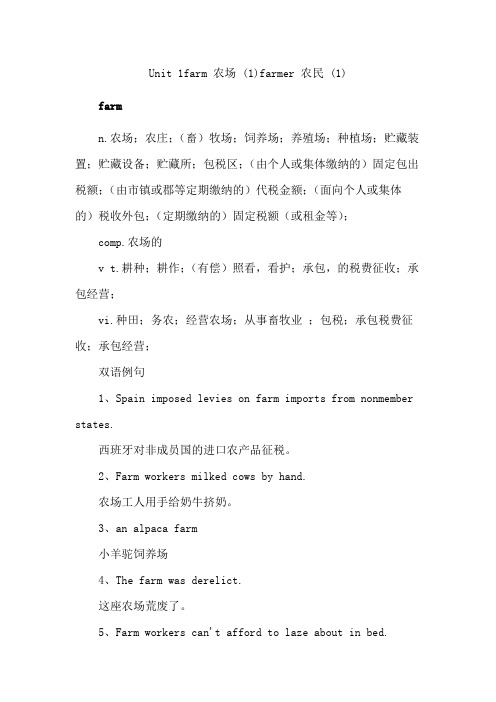
Unit 1farm 农场 (1)farmer 农民 (1)farmn.农场;农庄;(畜)牧场;饲养场;养殖场;种植场;贮藏装置;贮藏设备;贮藏所;包税区;(由个人或集体缴纳的)固定包出税额;(由市镇或郡等定期缴纳的)代税金额;(面向个人或集体的)税收外包;(定期缴纳的)固定税额(或租金等);comp.农场的v t.耕种;耕作;(有偿)照看,看护;承包,的税费征收;承包经营;vi.种田;务农;经营农场;从事畜牧业;包税;承包税费征收;承包经营;双语例句1、Spain imposed levies on farm imports from nonmember states.西班牙对非成员国的进口农产品征税。
2、Farm workers milked cows by hand.农场工人用手给奶牛挤奶。
3、an alpaca farm小羊驼饲养场4、The farm was derelict.这座农场荒废了。
5、Farm workers can't afford to laze about in bed.农场工人是不能懒洋洋地躺在床上的。
farmern.农场主;农场经营者;农民;农夫;包税人;承包人;保姆;(有偿)照看儿童者;双语例句1、I slept on the hay in the farmer's barn.我睡在农家谷仓内的干草上。
2、Otto was a farmer with bandy legs and a sad, weathered face.奥托是个农夫,长着一双罗圈腿和一张饱经风霜的苦脸。
3、The farmer liked to make a single plaited loaf.农夫喜欢做单辫结面包。
4、The farmer leant on his crook.农民靠在他的曲柄杖上。
5、Lambing is the climax of the sheep farmer's year.照料产羔母羊及新生羔羊是牧羊人一年工作中最激动人心的时候。
最新Animal Farm动物农场 或动物农庄 第一章 注释资料
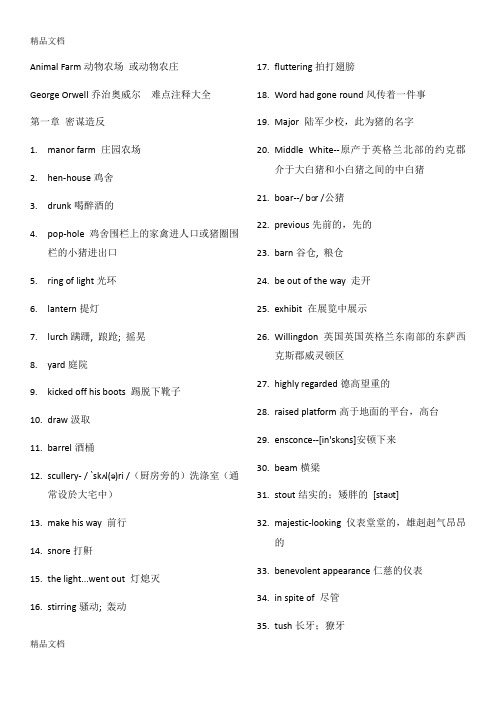
Animal Farm动物农场或动物农庄George Orwell乔治奥威尔难点注释大全第一章密谋造反1.manor farm 庄园农场2.hen-house鸡舍3.drunk喝醉酒的4.pop-hole鸡舍围栏上的家禽进人口或猪圈围栏的小猪进出口5.ring of light光环ntern提灯7.lurch蹒跚, 踉跄; 摇晃8.yard庭院9.kicked off his boots 踢脱下靴子10.draw汲取11.barrel酒桶12.scullery- / `skʌl(ə)ri /(厨房旁的)洗涤室(通常设於大宅中)13.make his way 前行14.snore打鼾15.the light...went out 灯熄灭16.stirring骚动; 轰动17.fluttering拍打翅膀18.Word had gone round风传着一件事19.Major 陆军少校,此为猪的名字20.Middle White--原产于英格兰北部的约克郡介于大白猪和小白猪之间的中白猪21.boar--/ bɔr /公猪22.previous先前的,先的23.barn谷仓, 粮仓24.be out of the way 走开25.exhibit 在展览中展示26.Willingdon英国英国英格兰东南部的东萨西克斯郡威灵顿区27.highly regarded德高望重的28.raised platform高于地面的平台,高台29.ensconce--[in'skɔns]安顿下来30.beam横梁31.stout结实的;矮胖的[staʊt]32.majestic-looking仪表堂堂的,雄赳赳气昂昂的33.benevolent appearance仁慈的仪表34.in spite of 尽管35.tush长牙;獠牙36.Before long不久,很快37.after their different fashions按各自不同的方式38.settle down安顿下来39.perch栖息40.window-sill窗台41.flutter拍打翅膀42.rafter 椽,承屋瓦的圆木y down --动词原形lie down躺下休息44.chew the cud反刍,fǎnchú45.偶蹄类的某些动物把粗粗咀嚼后咽下去的食物再反回到嘴里细细咀嚼,然后再咽下。
英语原版阅读:AtaDairyFarm
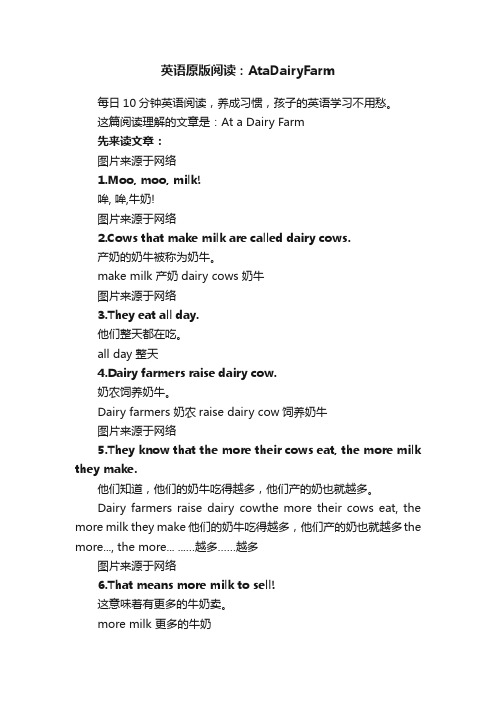
英语原版阅读:AtaDairyFarm每日10分钟英语阅读,养成习惯,孩子的英语学习不用愁。
这篇阅读理解的文章是:At a Dairy Farm先来读文章:图片来源于网络1.Moo, moo, milk!哞, 哞,牛奶!图片来源于网络2.Cows that make milk are called dairy cows.产奶的奶牛被称为奶牛。
make milk 产奶dairy cows 奶牛图片来源于网络3.They eat all day.他们整天都在吃。
all day 整天4.Dairy farmers raise dairy cow.奶农饲养奶牛。
Dairy farmers 奶农raise dairy cow饲养奶牛图片来源于网络5.They know that the more their cows eat, the more milk they make.他们知道,他们的奶牛吃得越多,他们产的奶也就越多。
Dairy farmers raise dairy cowthe more their cows eat, the more milk they make 他们的奶牛吃得越多,他们产的奶也就越多the more..., the more... ...…越多……越多图片来源于网络6.That means more milk to sell!这意味着有更多的牛奶卖。
more milk 更多的牛奶图片来源于网络7.A cow first makes milk when she has a calf.母牛生小牛时先产奶。
makes milk 产奶 has a calf 生小牛图片来源于网络k is food for the baby cow.牛奶是小牛的食物。
the baby cow 小牛图片来源于网络9.The cow will keep making milk even after the calf is grown.即使小牛长大了,这头母牛也会继续产奶。
- 1、下载文档前请自行甄别文档内容的完整性,平台不提供额外的编辑、内容补充、找答案等附加服务。
- 2、"仅部分预览"的文档,不可在线预览部分如存在完整性等问题,可反馈申请退款(可完整预览的文档不适用该条件!)。
- 3、如文档侵犯您的权益,请联系客服反馈,我们会尽快为您处理(人工客服工作时间:9:00-18:30)。
中文3715字外文文献翻译题目家庭农场学生姓名专业班级市场营销09-1学号 540906050151院(系)经济与管理学院指导教师(职称)家庭农场Lee, Jennifer Dukes U.S. Dept. of Agriculture, Economic Research Service New York摘要家庭农场是一个农场拥有和经营的家庭像其他家族企业和房地产的所有权,往往会给下一代的传承。
这是许多人类历史的主要是农业经济的基本单元,并继续在发展中国家。
家庭农场的替代品,包括那些由农业,俗称“工厂化农场,或通过集体农业。
关键词家庭农场/现代农业/发展/策略1 美国的法律定义所定义的美国农业部规定农场的贷款项目(例如那些由农业服务局管理),一个家庭农场是一个农场:(1)生产销售的农产品,这样的数量,是在社会公认的一个农场,没有农村住宅;(2)产生足够的收入(包括非农就业)支付的家庭和农场经营费用,偿还债务,并保持性能;(3)是由运营商管理;(4)具有通过运营商和运营商的家庭提供大量劳动力(5)可能在高峰时段和全职雇佣劳动力合理使用季节性劳动。
2 家庭农场的看法在发达国家的家庭农场是感伤的,为的是保存传统的缘故,一种生活方式,或是与生俱来的权利。
它往往对农业政策变化的政治口号是在这些国家,最常见的是在法国,日本,和美国,在农村的生活方式经常被看作是可取的。
在这些国家,同床异梦常常可以发现争论类似措施尽管在政治意识形态否则巨大差异。
例如,帕特里克布坎南和拉尔夫纳德,两位候选人在美国总统办公室举行集会,农村一起为维护所谓的家庭农场措施说话。
在其他经济事项,它们被视为普遍的反对,但发现这一共同点。
家庭农场的社会角色变化很大的今天。
直到最近,在与传统和保守的社会学,线家庭的头通常是最古老的人,紧随其后的是他的儿子。
妻子一般照顾家务,养育孩子,和财务事项有关的农场。
然而,农业活动已采取多种形式和随时间的变化。
农艺学,园艺,水产养殖,造林,和养蜂,随着传统的植物和动物,构成了今天的家庭农场方面。
农场的妻子常常需要找到工作离开农场,农场收入和儿童补充有时以农业为所选择的工作领域不感兴趣。
大胆的推动者认为,农业已成为更有效的与现代管理技术和新技术的应用在每一代,理想化的经典家庭农场现在是完全过时的,或更经常,无法无规模经济更大和更现代化的农场。
支持者认为,所有国家的家庭农场需要保护,为基础的农村社会与社会稳定。
3 家庭农场的可行性根据美国农业部,在美国所有的农场百分之九十八是家庭农场。
百分之二的农场不是家庭农场,和那些百分之二弥补在美国农业总产量的百分之十四,尽管他们中的一半已经低于50000美元/年销售总额。
总的来说,在美国的农场百分之九十一被认为是“家庭小农场”(以低于每年250000美元的销售),这些农场生产的美国农业产量的百分之二十七。
根据不同的类型和规模的独立运作,一些限制因素:(1)规模经济:更大的农场,可以讨价还价更具竞争力,购买更多的竞争,从高点和低点的经济利润,天气更容易通过货币惯性比小农场。
(2)肥料和其它投入成本可以大幅波动较大的季节,部分基于石油价格,范围为25%至200%是常见的几年。
(3)石油价格:直接(农机)和不那么直接(传输距离长;农药生产成本),石油的成本有很大的影响,今年所有机械化传统农场年存活率。
(4)商品期货的商品作物,生猪,粮食等价格,预测,可以决定提前一个赛季似乎变得经济可行的。
(5)技术的用户协议:一个不公开的因子,专利的GE的种子,被广泛用于多种作物,如棉花和大豆,有限制的使用,甚至可以包括那些作物可以卖到。
(6)批发的基础设施:农民日益增长的大量的作物可以直接销售给消费者,必须满足一系列的标准出售进入批发市场,其中包括收获时间和分级质量,并且还可以包括品种,因此,市场渠道真的决定决策方面的农场。
(7)融资可用性:更大的农场,今天通常依靠信用额度,通常从银行,购买农药,并为每个生长年限需要其他用品。
这些线是由几乎所有的其他制约因素的严重影响。
(8)政府的经济干预:在一些国家,尤其是美国和欧盟,政府对农民的补贴,旨在减轻对其他经济领域的经济和政治活动的国内农民的影响,可以是农场收入的一大来源。
当危机救助,如干旱或“疯牛病”问题影响的农业部门,也依赖于。
很大程度上,这种情况是由于大规模的全球市场的农场不得不参与。
(9)政府和行业监管:配额范围广,营销委员会和立法强加限制农业复杂,往往需要大量的资源导航。
例如,在小农场,在许多司法管辖区,有对牲畜的销售严重限制或禁止,奶制品和鸡蛋。
这些来自各方的压力:食品安全,环境,市场营销。
(10)房地产价格:世界各地的城市中心的增长,以及由此产生的城市扩张导致了位于市中心的农田飞涨的价格,同时减少必要的支持农业的基础设施,许多农民将有效压力卖掉。
在第二十世纪,发达国家的人们都把大部分的步骤走下去,这种情况。
个体农民选择了新技术的连续波,高兴的马匹拖拉机交易,增加他们的债务,他们的生产能力。
这反过来又需要更大,更遥远的市场,更重和更复杂的融资。
公众愿意购买越来越商品化,加工,运输和相对便宜的食品。
日益多样化的一个新鲜的,未固化的供应,在一年四季的新鲜农产品和肉类(桔子在一月,刚宰杀的肉牛在七月,鲜猪肉,而不是盐腌,烟熏,或钾浸渍火腿)打开了一个全新的美食和消费者谁从来没有享受过这样的产生之前,数以百万计的人前所未有的健康饮食。
这些能力也为市场带来了前所未有的多种加工食品,如玉米糖浆和漂白粉。
为家庭农场这一新技术和日益复杂的市场营销策略提出了前所未有的新挑战,并不是所有的家庭的农民已经能够有效地应对不断变化的市场条件。
4 二十一世纪的家庭农场它究竟有什么“田园”生命的存在,对于大多数的家庭农场消失了近几十年来,数以百万计的人。
在第二十世纪初,在美国北部一个农场的平均每英亩比现在少得多的食物。
一个可能的结论是,在上世纪中叶的几十年的时间,大量的农场利用迅速崛起的新技术,市场取得了暂时的舒适的位置,和生长取向的哲学。
由于经济增长和“生产效率”的不断增加,这个位置开始改变明显,至少在20世纪70年代。
农场的数量,以及生活在这个土地的农场家庭,下降每十年在美国自1920。
这部分是规模经济和竞争压力的函数。
部分,这可能被视为一个迹象表明,“家庭农场”,在其原始形式,现实,只是普通的辛勤工作,与有限的社会和文化的机会,竞争对手不作为一种职业,城市和郊区的一个“生活方式”的机会。
在当前的形势下,为独立的“农家”恢复任何实际的经济独立,它似乎是必要的,整个食品行业重组。
此外,给出了失效的家庭农场的极数,这是没有那么多的储蓄或维护家庭农场一事,但使用剩余的知识,技能和农场的“新家庭农场的框架。
一个严重的问题,但是,是整个食品系统应该是“重组”为了保存一个失败或者神话的理想,或是世界上的人口,现在接近7000000000人,将持续的返回劳动密集型农业和当地的妈妈和流行的营销实践。
然而,答案,很难被认为是显而易见的,尤其是因为许多这些7000000000人可能发现他们喜欢种植食物的当前城市下层选项如数据录入,食品服务,电话。
在“家庭农场”的进化的一个例子,北达科他州的历史是照明。
虽然最初作为巨大的“富矿农场”在19世纪70年代,这些被拆分出售成小集团和国家其他地区移民节段(160英亩(0.65平方公里))的农场。
国家主要养殖由20世纪20、30年代的个人和家庭的国家。
早在第二十世纪,享有一个民粹主义的繁荣,农民控制议会获得了农产品营销和销售放在国家资助的合作社,使小生产者摆脱铁路和工业化食品商握力控制。
这些政策长期以来被遗弃。
2007,在北达科他州的大部分土地仍归个人所有。
农地所有权已在1933个州的选民倡议是违法的。
农业的规模在北达科他州,然而,不是混合农业家庭经营的实践。
典型的旱地小麦农场在北达科他州由几千亩的规模上的设备匹配。
这些农场的生产组装120辆火车运送到遥远的市场作为国际商业流的一部分。
场等这通常是由十五,二十或更多的移民节段,同时含有“家庭农场”的土地,由大量的废弃的农场,鬼城的见证,和被遗弃的乡村教堂和墓地纪念一个更大的农村人口,早已消失。
成千上万的废弃或闭塞的农场,在北达科他州的农村人口减少的其他证据,包括许多蓬勃发展家庭农场到70年代现在空置和恶化的家园,是一个与浪漫的概念中的“家庭农场”在第二十一世纪。
5 当地的食品和有机运动在过去的几十年里,已经有一个在有机和自由放养的食物的兴趣的复苏。
消费者的一个百分比也开始质疑工业农业实践的可行性和转向有机食品销售家庭农场上不仅包括肉类和生产,而且由于小麦胚芽面包和天然碱肥皂之类的东西,所生产的产品(如反对漂白的白面包和基于洗涤剂条石油)。
有些人买这些产品直接来自家庭农场。
“新家庭农场”提供了一种替代市场在一些地方与阵列的传统和自然产生的产品。
这样的“有机”和“自由”的农业是可以达到的,富裕的城市和郊区的相当数量的消费者愿意支付溢价的理想的“本地生产的产品”和“人道对待动物”。
有时,这些农场的爱好或兼职的合资企业,或从其他来源的财富支持。
可行的农场规模足以支持现代家庭的收入水平与城市和郊区的中产阶级的家庭往往是大型活动相适应的,无论在面积和资本要求。
这些农场,家庭拥有和在技术上和经济上的常规的方式运行,生产的农作物和动物产品面向国内和国际市场,而不是当地市场。
在评估这一复杂的经济形势,这是要考虑所有这些农场收入来源的重要;例如,农业补贴,美国政府提供的每年数百万美元。
由于燃料价格上涨,运到国内和国际市场食品已经涨价。
参考文献[1]J. Arbuckle.Non-operator landowner interest in agroforestry practices in two Missouri watersheds[D].Agroforestry Systems, 75 (2009), pp. 73–82[2]C. Barbieri, E. Mahoney, L. Butler.Understanding the nature and extent of farm and ranchdiversification in North America[J].Rural Sociology, 73 (2008), pp. 205–229[3]C. Barbieri, E. Mahoney.Why is diversification an attractive farm adjustment strategy? Insightsfrom Texas farmers and ranchers[J].Journal of Rural Studies, 25 (2009), pp. 58–66[4]C. Barbieri, P. Mshenga.The role of firm and owner characteristics on the performance ofagritourism farms[D].Sociologia Ruralis, 48 (2008), pp. 166–183[5]C. Barbieri, C. Valdivia.Recreational multifunctionality and its implications for agroforestrydiffusion[D].Agroforestry Systems, 79 (1) (2010), pp. 5–18[6]D. Bateman, C. Ray.Farm pluriactivity and rural policy: some evidence from Wales[D].Journal ofRural Studies, 10 (1994), pp. 1–13[7]H. Garrett .North American Agroforestry: An Integrated Science and Practice [D].AmericanSociety of Agronomy, Madison (2009), pp. 75–104[8]S.J. Breckler.Empirical validation of affect, behavior, and cognition as distinct components ofattitude[D].Journal of Personality and Social Psychology, 47 (6) (1984), pp. 1191–1205[9]L. Buck.Agroforestry policy issues and research direction in the U.S and less developed countries:insights and challenges from recent experience[J].Agroforestry Systems, 30 (1995), pp. 57–73 [10]T. Dobbs, J. Pretty.Agri-environmental stewardship schemes and multifunctionality[D].Reviewof Agricultural Economics, 26 (2004), pp. 220–237FAMILY FARMABSTRACTA family farm is a farm owned and operated by a family Like other family businesses and real estate, ownership often passes to the next generation by inheritance. It is the basic unit of the mostly agricultural economy of much of human history and continues to be so in developing nations. Alternatives to family farms include those run by agribusiness, colloquially known as factory farms, or by collective farming.KEY WORDS Family Farm, Modern Agriculture, Development, Tactics United States legal definitionAs defined by USDA regulations to farm loan programs (e.g. those administered by the Farm Service Agency), a family farm is a farm that:(1)produces agricultural commodities for sale in such quantities so as to be recognized in the community as a farm and not a rural residence;(2)produces enough income (including off-farm employment) to pay family and farm operating expenses, pay debts, and maintain the property;(3)is managed by the operator;(4)has a substantial amount of labor provided by the operato r and the operator’s family;(5)may use seasonal labor during peak periods and a reasonable amount of full-time hired labor.Perceptions of the family farmIn developed countries the family farm is viewed sentimentally, as a lifestyle to be preserved for tradition's sake, or as a birthright. It is in these nations very often a political rallying cry against change in agricultural policy, most commonly in France, Japan, and the United States, where rural lifestyles are often regarded as desirable. In these countries, strange bedfellows can often be found arguing for similar measures despite otherwise vast differences in political ideology. For example, Patrick Buchanan and Ralph Nader, both candidates for the office of President of the United States, held rural rallies together and spoke for measures to preserve the so-called family farm. On other economic matters they were seen as generally opposed, but found common ground on this one.The social roles of family farms are much changed today. Until recently, staying in line with traditional and conservative sociology, the heads of the household were usually the oldest man followed closely by his oldest sons. The wife generally took care of the housework, child rearing, and financial matters pertaining to the farm. However, agricultural activities have taken on many forms and change over time. Agronomy, horticulture, aquaculture, silviculture, and apiculture, along with traditional plants and animals, all make up aspects of today's family farm. Farm wives often need to find work away from the farm to supplement farm income and children sometimes have no interest in farming as their chosen field of work.Bolder promoters argue that as agriculture has become more efficient with the application of modern management and new technologies in each generation, the idealized classic family farm is now simply obsolete, or more often, unable to compete without the economies of scale available to larger and more modern farms. Advocatesargue that family farms in all nations need to be protected, as the basis of rural society and social stability.Viability of the family farmAccording to the United States Department of Agriculture, ninety-eight percent of all farms in the U.S. are family farms. Two percent of farms are not family farms, and those two percent make up fourteen percent of total agricultural output in the United States, although half of them have total sales of less than $50,000 per year. Overall, ninety-one percent of farms in the United States are considered "small family farms" (with sales of less than $250,000 per year), and those farms produce twenty-seven percent of U.S. agricultural output.Depending on the type and size of independently owned operation, some limiting factors are:(1)Economies of scale: Larger farms are able to bargain more competitively, purchase more competitively, profit from economic highs, and weather lows more readily through monetary inertia than smaller farms.(2)Cost of inputs: fertilizer and other agrichemicals can fluctuate dramatically from season to season, partially based on oil prices, a range of 25% to 200% is common over a few year period.(3)oil prices: Directly (for farm machinery) and somewhat less directly (long distance transport; production cost of agrichemicals), the cost of oil significantly impacts the year-to-year viability of all mechanized conventional farms.(4)commodity futures: the predicted price of commidity crops, hogs, grain, etc., can determine ahead of a season what seems economically viable to grow.(5)technology user agreements: a less publicly known factor, patented GE seed that is widely used for many crops, like cotton and soy, comes with restrictions on use, which can even include who the crop can be sold to.(6)wholesale infrastructure: A farmer growing larger quantities of a crop than can be sold directly to consumers has to meet a range of criteria for sale into the wholesale market, which include harvest timing and graded quality, and may also include variety, therefore, the market channel really determines most aspects of the farm decisionmaking.(7)availability of financing: Larger farms today often rely on lines of credit, typically from banks, to purchase the agrichemicals, and other supplies needed for each growing year. These lines are heavily affected by almost all of the other constraining factors.(8)government economic intervention: In some countries, notably the US and EU, government subsidies to farmers, intended to mitigate the impact on domestic farmers of economic and political activities in other areas of the economy, can be a significant source of farm income. Bailouts, when crises such as drought or the "mad cow disease" problems hit agricultural sectors, are also relied on. To some large degree, this situation is a result of the large-scale global markets farms have no alternative but to participate in.(9)government and industry regulation: A wide range of quotas, marketing boards and legislation governing agriculture impose complicated limits, and often require significant resources to navigate. For example, on the small farming end, in many jurisdictions, there are severe limits or prohibitions on the sale of livestock, dairy and eggs. These have arisen from pressures from all sides: food safety, environmental, industry marketing.(10)real estate prices: The growth of urban centers around the world, and the resulting urban sprawl have caused the price of centrally located farmland to skyrocket,while reducing the local infrastructure necessary to support farming, putting effectively intense pressure on many farmers to sell out.Over the 20th century, the people of developed nations have collectively taken most of the steps down the path to this situation. Individual farmers opted for successive waves of new technology, happily "trading in their horses for a tractor", increasing their debt and their production capacity. This in turn required larger, more distant markets, and heavier and more complex financing. The public willingly purchased increasingly commoditized, processed, shipped and relatively inexpensive food. The availability of an increasingly diverse supply of fresh, uncured, unpreserved produce and meat in all seasons of the year (oranges in January, freshly killed steers in July, fresh pork rather than salted, smoked, or potassium-impregnated ham) opened an entirely new cuisine and an unprecedented healthy diet to millions of consumers who had never enjoyed such produce before. These abilities also brought to market an unprecedented variety of processed foods, such as corn syrup and bleached flour. For the family farm this new technology and increasingly complex marketing strategy has presented new and unprecedented challenges, and not all family farmers have been able to effectively cope with the changing market conditions.Family farms in the 21st centuryIt is arguable whether any sort of "idyllic" life existed for most of the millions of family farms that have disappeared in recent decades. At the beginning of 20th century, an average farm in North America produced much less food per acre than it does nowadays. A likely conclusion is that for a time in the middle decades of the last century, a large number of farms achieved a temporarily comfortable position by capitalizing on rapidly emerging new technologies, markets, and growth-oriented philosophies. As growth and "production efficiency" kept increasing, this position began to reverse noticeably, at least by the 1970s. The number of farms, and of farm families living on the land, has dropped every decade in the United States since 1920. Inpart this was a function of economies of scale and competitive pressures. In part it may be perceived as an indication that "family farming", in its raw, realistic form, is just plain hard work, with limited social and cultural opportunities, and competes poorly as an occupation and a "lifestyle" with urban and suburban opportunities.In the current situation, for the independent "family farmer" to regain any sort of practical economic independence, it would seem necessary that the entire food industry be restructured. Furthermore, given the extreme number of defunct family farms, it is not so much a matter of saving or preserving the family farm, but of using the remaining knowledge, expertise and farms as the framework for the "new family farm." A serious question, however, is whether the entire food system should be "restructured" in order to preserve a failed or perhaps mythological ideal, or whether the population of the world, now approaching 7 billion people, will be sustained by a return to labor-intensive farming and local mom and pop marketing practices. The answer, however, can hardly be considered immediately obvious, especially since many of these 7 billion people might find they prefer growing food to current urban lower-class options such as data entry, food service, and telemarketing.As an example of the evolution of the "family farm", the history of North Dakota is illuminating. Although originally developed as enormous "bonanza farms" in the 1870s, these were broken up and sold off into smaller holdings and other parts of the state were homesteaded in quarter section (160-acre (0.65 km2)) farms. The state was predominantly farmed by individuals and families by the 1920s and 1930s. The state enjoyed a populist boom in the early 20th century, as farmer-controlled legislatures gained control of the marketing and sale of agricultural products and placed it in state-sponsored cooperatives to enable smaller producers to escape the grip of the railroads and the industrialized food merchants. These polices have long since been abandoned. In 2007, most farmland in North Dakota remains owned by individuals. Corporate ownership of farmland has been illegal since a statewide voter initiative in 1933. The scale of agriculture in North Dakota, however, is not a hands-on familyoperation of mixed agriculture. The typical dry-land wheat farm in North Dakota consists of several thousand acres with equipment on a scale to match. The produce of these farms is assembled on 120-car trains and shipped to distant markets as part of the international stream of commerce.Farms such as this typically are aggregations of fifteen, twenty or more homesteaded quarter sections of land which at one time contained "family farms", as witnessed by the numerous abandoned farmsteads, ghost towns, and abandoned country churches and cemeteries memorializing a much larger rural population that is long since disappeared.The thousands of abandoned or obliterated farmsteads and other evidence of rural depopulation in North Dakota, including many now-vacant and deteriorated homesteads which were thriving family farms into the 1970s, are a counterpoint to romantic notions of "family farming" in the 21st century.Local food and the organic movementIn the last few decades there has been a resurgence of interest in organic and free range foods. A percentage of consumers have begun to question the viability of industrial agriculture practices and have turned to organic groceries that sell products produced on family farms including not only meat and produce but also such things as wheat germ breads and natural lye soaps (as opposed to bleached white breads and petroleum based detergent bars). Others buy these products direct from family farms. The "new family farm" provides an alternative market in some localities with an array of traditionally and naturally produced products.Such "organic" and "free-range" farming is attainable where a significant number of affluent urban and suburban consumers willingly pay a premium for the ideals of "locally produced produce" and "humane treatment of animals". Sometimes, these farms are hobby or part-time ventures, or supported by wealth from other sources. Viablefarms on a scale sufficient to support modern families at an income level commensurate with urban and suburban upper-middle-class families are often large scale operations, both in area and capital requirements. These farms, family owned and operated in a technologically and economically conventional manner, produce crops and animal products oriented to national and international markets, rather than to local markets. In assessing this complex economic situation, it is important to consider all sources of income available to these farms; for instance, the millions of dollars in farm subsidies which the United States government offers each year. As fuel prices rise, foods shipped to national and international markets are already rising in price.Reference[1]J. Arbuckle.Non-operator landowner interest in agroforestry practices in two Missouriwatersheds[D].Agroforestry Systems, 75 (2009), pp. 73–82[2]C. Barbieri, E. Mahoney, L. Butler.Understanding the nature and extent of farm and ranchdiversification in North America[J].Rural Sociology, 73 (2008), pp. 205–229[3]C. Barbieri, E. Mahoney.Why is diversification an attractive farm adjustment strategy? Insightsfrom Texas farmers and ranchers[J].Journal of Rural Studies, 25 (2009), pp. 58–66[4]C. Barbieri, P. Mshenga.The role of firm and owner characteristics on the performance ofagritourism farms[D].Sociologia Ruralis, 48 (2008), pp. 166–183[5]C. Barbieri, C. Valdivia.Recreational multifunctionality and its implications for agroforestrydiffusion[D].Agroforestry Systems, 79 (1) (2010), pp. 5–18[6]D. Bateman, C. Ray.Farm pluriactivity and rural policy: some evidence from Wales[D].Journal ofRural Studies, 10 (1994), pp. 1–13[7]H. Garrett .North American Agroforestry: An Integrated Science and Practice [D].AmericanSociety of Agronomy, Madison (2009), pp. 75–104[8]S.J. Breckler.Empirical validation of affect, behavior, and cognition as distinct components ofattitude[D].Journal of Personality and Social Psychology, 47 (6) (1984), pp. 1191–1205[9]L. Buck.Agroforestry policy issues and research direction in the U.S and less developed countries:insights and challenges from recent experience[J].Agroforestry Systems, 30 (1995), pp. 57–73[10]T. Dobbs, J. Pretty.Agri-environmental stewardship schemes and multifunctionality[D].Reviewof Agricultural Economics, 26 (2004), pp. 220–237。
